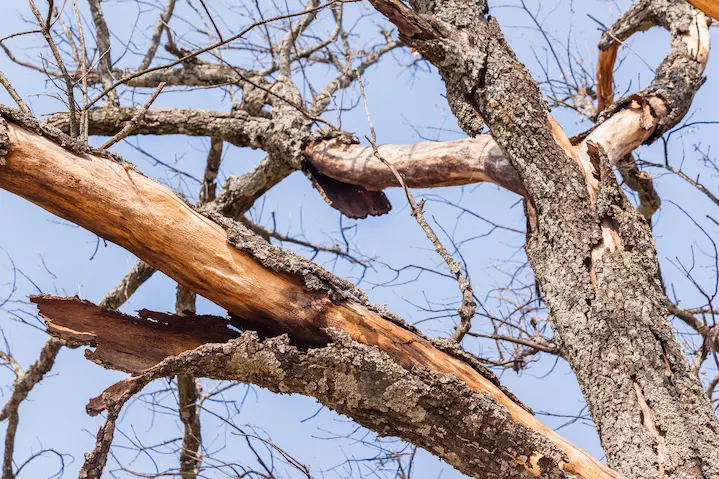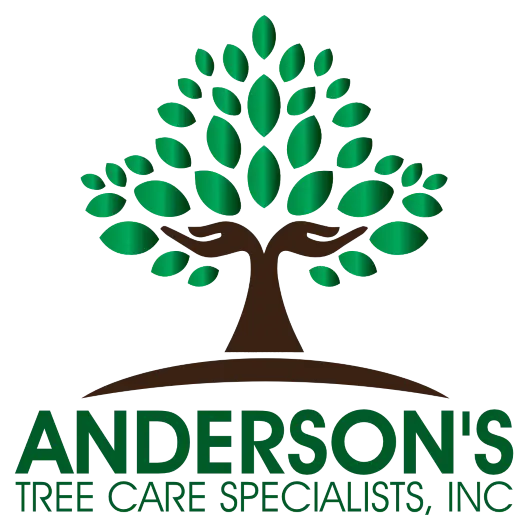
Trees are important pieces of any landscape, providing shade, a pretty sight to look at, and cleaner air. But what should you do when a tree starts showing signs of distress? Restoring a struggling tree requires identifying the underlying issue and implementing targeted solutions. This often involves proper watering, soil improvement, strategic pruning, pest control, and, when necessary, the guidance of an expert.
Diagnosing the problem and determining the best course of action can be challenging. Many homeowners feel powerless as they watch their beloved trees deteriorate without knowing how to help.
That’s where Anderson’s Tree Care comes in. Our certified arborists combine deep local expertise with years of hands-on experience to address every situation. Instead of simply treating symptoms, we focus on the root cause, delivering customized care to help your trees thrive.
10 Common Problems Trees Face
Trees often die as a result of a combination of environmental stressors and biological issues. Here are some of the most common causes of tree decline:
- Overwatering or underwatering
- Compacted or nutrient-poor soil
- Pest infestations
- Infections caused by harmful fungi or bacteria
- Physical damage from storms, construction, or improper pruning
- Exposure to pollutants or chemicals
- Stress from extreme weather conditions, such as drought
- Nutritional deficiencies
- Root damage or disease
- Competition from invasive species
Where to Check if Your Tree Needs Help
You can identify a dying tree by looking for several key indicators, including:
- An absence of leaves during the growing season
- Dry, brittle branches that snap easily
- Bark that is peeling off or completely missing
- Fungal growth visible on the trunk
Another simple way to check is by performing a “scratch test.” Gently scratch the bark to see if there is green tissue underneath. If no green is visible, the tree is likely in severe decline or already dead.
Need a Tree and Plant Healthcare Estimate?
Click below to leave your information and we will call you right back!
Ready to schedule your tree & plant care service?
Leave your information below and we will give you a call back.
*During normal business hours. After hours calls will be returned the next business day.
When to Remove a Dying Tree
Because of the safety risks, it’s important to remove a dead tree as soon as you notice the damage. Dead trees are structurally unstable and can fall without warning, therefore they are a constant hazard to people and property until they’re removed. They can also become a haven for pests and diseases, which may spread to other healthy trees in your yard or neighborhood.
Don’t ignore the problem, but avoid attempting to remove the tree yourself. Tree removal, especially for large trees, is a hazardous task that requires proper training and specialized equipment. Hiring a professional ensures the tree is removed safely and efficiently, following strict safety standards.
The goal of a professional removal is to eliminate the dead tree without harming your property or surrounding greenery. Additionally, a professional can advise you on replanting options to maintain the beauty and ecological balance of your outdoor space.
How to Prevent Dead Trees
To revive a struggling tree, begin with a thorough assessment of its condition. Preferably, this should be carried out by an experienced professional, who can catch small details that are easy to overlook. This process requires an examination of the tree from its roots to its crown, looking for stress indicators like yellowing leaves, damaged bark, or unusual growth patterns. Once the root cause is identified, a tailored treatment plan can be created, which may include improving soil health, careful pruning, or treating pests and diseases with targeted methods.
Remember, trees are complex organisms, and what works for one type of tree may not be effective for another.
Keep Your Home Safe with Healthy Trees
Just like family pets, your trees benefit from consistent care and expert attention. Ongoing tree maintenance creates a nurturing environment where your trees can thrive year after year. Healthy trees do more than improve your yard—they increase property value, provide refreshing shade, and help purify the air!
Sadly, many homeowners only become aware of tree issues after they’ve become major problems, which is typically too late for the tree to be saved. Losing valuable trees can be a large investment loss, especially if it was preventable. At Anderson’s Tree Care, we combat this by offering customized tree health programs tailored to the unique needs of your landscape.
Our certified specialists have local knowledge and a thorough understanding of the challenges posed by California’s climate and soil conditions. We are able to spot early signs of stress that others might miss, and use this information to create proactive strategies that prevent minor issues from turning into serious problems.
Get in touch with us today for a service quote and take the first step toward preserving the health, beauty, and longevity of your trees!
Back to Tree and Plant HealthcareHow To Repair a Dying Tree in the San Jose Metro Area
Serving San Jose CA
San Jose | Fremont | Newark (CA) | Milpitas | Mountain View | Stanford | Palo Alto | East Palo Alto | Woodside | San Mateo | San Carlos
Redwood City | Los Gatos | Saratoga | Cupertino | Fruitdale | Campbell | Alamitos | Santa Clara | Coyote | Morgan Hill | San Martin | Gilroy
Home » Tree and Plant Healthcare » How To Repair a Dying Tree



